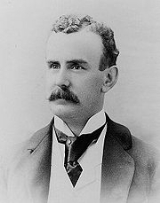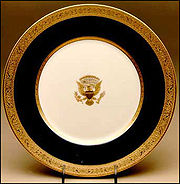
Walter Scott Lenox
Encyclopedia


United States
The United States of America is a federal constitutional republic comprising fifty states and a federal district...
businessman who established Lenox china, supplying the first complete American-made bone china table service
Bone china
Bone china is a type of soft-paste porcelain that is composed of bone ash, feldspathic material and kaolin. It has been defined as ware with a translucent body containing a minimum of 30% of phosphate derived from animal bone and calculated calcium phosphate...
for Woodrow Wilson
Woodrow Wilson
Thomas Woodrow Wilson was the 28th President of the United States, from 1913 to 1921. A leader of the Progressive Movement, he served as President of Princeton University from 1902 to 1910, and then as the Governor of New Jersey from 1911 to 1913...
's White House
White House
The White House is the official residence and principal workplace of the president of the United States. Located at 1600 Pennsylvania Avenue NW in Washington, D.C., the house was designed by Irish-born James Hoban, and built between 1792 and 1800 of white-painted Aquia sandstone in the Neoclassical...
.
Biography
Lenox resolved to become a ceramicist early in his boyhood. Starting in 1875 at the age of sixteen he first did work for several Trenton potteries. He had developed an excellent reputation in the early 1880s when he was in his twenties and based on this he was hired by Ott and Brewer Pottery Company of Trenton, then Willetts Manufacturing, as its factory art design director. Then he focused on ceramic design and decoration.When Lenox was thirty he had saved enough money to enter a partnership with a Jonathan Coxon. They opened a firm called the Ceramic Art Company. Lenox wanted to be an expert in producing quality bone china. In the nineteenth century American ceramics and pottery were inferior to European products. Wealthy Americans would buy European dinner services and tableware when they were looking for quality. Lenox at this point had three things to accomplish for his goal to produce quality bone china:
- master the difficult bone china manufacturing techniques
- obtain sufficient financial backing for his factory operations
- overcome the wealthy’s prejudices against American bone china
Ceramic Art Company struggled financially in the early years of its operation. The material and labor costs exceeded the profits they were getting from the sales of their products. Lenox bought out Coxon’s interest in the company in 1894. From then on he operated it on his own, as Lenox's Ceramic Art Company. He concentrated on manufacturing Belleek style pottery
Belleek Pottery Ltd
Belleek Pottery Ltd is a porcelain company that began trading in 1887 as the Belleek Pottery Works Company Ltd in Belleek, County Fermanagh, in what was to become Northern Ireland. The factory produces porcelain that is characterised by its thinness, slightly iridescent surface and that the body is...
. This is a ware of a rich, thin, ivory-colored porcelain of extremely high quality as manufactured in Belleek, Ireland
Belleek, County Fermanagh
Belleek is a village in County Fermanagh, Northern Ireland. While the greater part of the village lies within County Fermanagh, part of it crosses the border into County Donegal, a part of Ulster that lies in the Republic of Ireland. This makes Belleek the western-most village in the United Kingdom...
. Lenox even hired two expert Belleck potters from Ireland to help him master the technique. The troubled company, however, only went further in debt with the lack of sales and profits. He even had to consent to a new factory building being so designed and constructed as to be able to be easily converted into an apartment building if his company failed.
In the early part of the 1900s Lenox's health began to go on a decline. He was becoming paralyzed and going blind. However, Lenox continued to work at the factory daily increasing his efforts. His chauffeur carried him to his office where he began to monitor the production of porcelain with his hands. He relied heavily on trusting his assistant and secretary Harry Brown, a long-time employee.
In 1906 Lenox established Lenox, Inc. Lenox’s company finally received a large order from Shreve and Company, a retailer. Soon after the delivery, the retailer’s store was leveled in the 1906 San Francisco earthquake
1906 San Francisco earthquake
The San Francisco earthquake of 1906 was a major earthquake that struck San Francisco, California, and the coast of Northern California at 5:12 a.m. on Wednesday, April 18, 1906. The most widely accepted estimate for the magnitude of the earthquake is a moment magnitude of 7.9; however, other...
and everything destroyed, except for a single glazed Lenox bone china plate that looked as exquisite as it had on the day it was manufactured. This plate became the cornerstone of Lenox's marketing campaign.
Lenox made the first complete set of American made Bone china
Bone china
Bone china is a type of soft-paste porcelain that is composed of bone ash, feldspathic material and kaolin. It has been defined as ware with a translucent body containing a minimum of 30% of phosphate derived from animal bone and calculated calcium phosphate...
dishware for the White House
White House
The White House is the official residence and principal workplace of the president of the United States. Located at 1600 Pennsylvania Avenue NW in Washington, D.C., the house was designed by Irish-born James Hoban, and built between 1792 and 1800 of white-painted Aquia sandstone in the Neoclassical...
, which was for President Woodrow Wilson
Woodrow Wilson
Thomas Woodrow Wilson was the 28th President of the United States, from 1913 to 1921. A leader of the Progressive Movement, he served as President of Princeton University from 1902 to 1910, and then as the Governor of New Jersey from 1911 to 1913...
.

